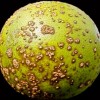 El cancro cítrico es una enfermedad introducida en Florida y es muy perjudicial económicamente para la industria comercial. La enfermedad no está presente en todas las regiones tropicales y subtropicales productoras de cítricos donde el cancro cítrico puede ser problemático, por lo tanto, las restricciones para exportar fruta con cancro cítrico son muy estrictas. Esta enfermedad también concierne a los propietarios, no solo por sus efectos en la industria económica, sino también porque es altamente contagiosa y la mayoría de la fruta contagiada en un árbol muy afectado se cae de éste prematuramente. This 4-page fact sheet was written by M. M. Dewdney, P. D. Roberts, J. H. Graham, K. R. Chung, and M. Zekri, and published by the UF Department of Plant Pathology, January 2013.
El cancro cítrico es una enfermedad introducida en Florida y es muy perjudicial económicamente para la industria comercial. La enfermedad no está presente en todas las regiones tropicales y subtropicales productoras de cítricos donde el cancro cítrico puede ser problemático, por lo tanto, las restricciones para exportar fruta con cancro cítrico son muy estrictas. Esta enfermedad también concierne a los propietarios, no solo por sus efectos en la industria económica, sino también porque es altamente contagiosa y la mayoría de la fruta contagiada en un árbol muy afectado se cae de éste prematuramente. This 4-page fact sheet was written by M. M. Dewdney, P. D. Roberts, J. H. Graham, K. R. Chung, and M. Zekri, and published by the UF Department of Plant Pathology, January 2013.
http://edis.ifas.ufl.edu/pp298
Tag: K.R. Chung
Citrus Diseases Exotic to Florida: Citrus Yellow Mosaic (PP293)
Citrus yellow mosaic is an important viral disease in India, where it causes significant yield reduction. In some groves, infection rate may be as high as 70%. CYMV induces a bright yellow mottling or vein flecking that persists in mature leaves. Yields are sharply reduced in chronically infected ‘Sathgudi’ sweet orange trees in India, and fruit may also show mosaic symptoms. This 2-page fact sheet was written by K.-R. Chung and R. H. Brlansky, and published by the UF Department of Plant Pathology, February 2012.
http://edis.ifas.ufl.edu/pp293
Citrus Diseases Exotic to Florida: Mal Secco (PP290)
 Mal secco, Italian for “dry disease”, is a fungal disease that causes serious damage to a number of citrus cultivars in the Mediterranean and Black Sea areas, but has not been reported in other citrus-growing regions. The main diagnostic field symptom is that wood of affected limbs has a reddish-yellow stain. This 3-page fact sheet was written by K.-R. Chung, and published by the UF Department of Plant Pathology, February 2012.
Mal secco, Italian for “dry disease”, is a fungal disease that causes serious damage to a number of citrus cultivars in the Mediterranean and Black Sea areas, but has not been reported in other citrus-growing regions. The main diagnostic field symptom is that wood of affected limbs has a reddish-yellow stain. This 3-page fact sheet was written by K.-R. Chung, and published by the UF Department of Plant Pathology, February 2012.
http://edis.ifas.ufl.edu/pp290
Citrus Diseases Exotic to Florida: Satsuma Dwarf (PP291)
 Satsuma dwarf is a virus disease that was first reported in the early 1930s in Japan. The disease causes serious problems in citrus because it reduces tree vigor and fruit yield. Satsuma dwarf has also been reported in mandarin-growing areas in China, Korea, and Turkey, where it was likely introduced through importation of infected budwood from Japan. This 2-page fact sheet was written by K.-R. Chung and R.H. Brlansky, and published by the UF Department of Plant Pathology, February 2012.
Satsuma dwarf is a virus disease that was first reported in the early 1930s in Japan. The disease causes serious problems in citrus because it reduces tree vigor and fruit yield. Satsuma dwarf has also been reported in mandarin-growing areas in China, Korea, and Turkey, where it was likely introduced through importation of infected budwood from Japan. This 2-page fact sheet was written by K.-R. Chung and R.H. Brlansky, and published by the UF Department of Plant Pathology, February 2012.
http://edis.ifas.ufl.edu/pp291
Citrus Diseases Exotic to Florida: Powdery Mildew (PP288)
 Powdery mildew, which affects almost all citrus cultivars, is a common fungal disease problem in Asian countries. This 2-page fact sheet provides background information for this disease to provide a basis for evaluating potential risk to Florida citrus and for aiding decision-making to prevent its introduction and spread in Florida. It was written by K.-R. Chung and published by the UF Department of Plant Pathology, October 2011.
Powdery mildew, which affects almost all citrus cultivars, is a common fungal disease problem in Asian countries. This 2-page fact sheet provides background information for this disease to provide a basis for evaluating potential risk to Florida citrus and for aiding decision-making to prevent its introduction and spread in Florida. It was written by K.-R. Chung and published by the UF Department of Plant Pathology, October 2011.
http://edis.ifas.ufl.edu/pp288
PP194/PP116 Homeowner Fact Sheet: Citrus Canker
Revised! PP194, a 4-page illustrated fact sheet by M.M. Dewdney, P.D. Roberts, J.H. Graham, K.R. Chung, and M. Zekri, informs homeowners about this serious disease of citrus, its history, symptoms, spread, and control strategies. Published by the UF Department of Plant Pathology, October 2009.
http://edis.ifas.ufl.edu/PP116